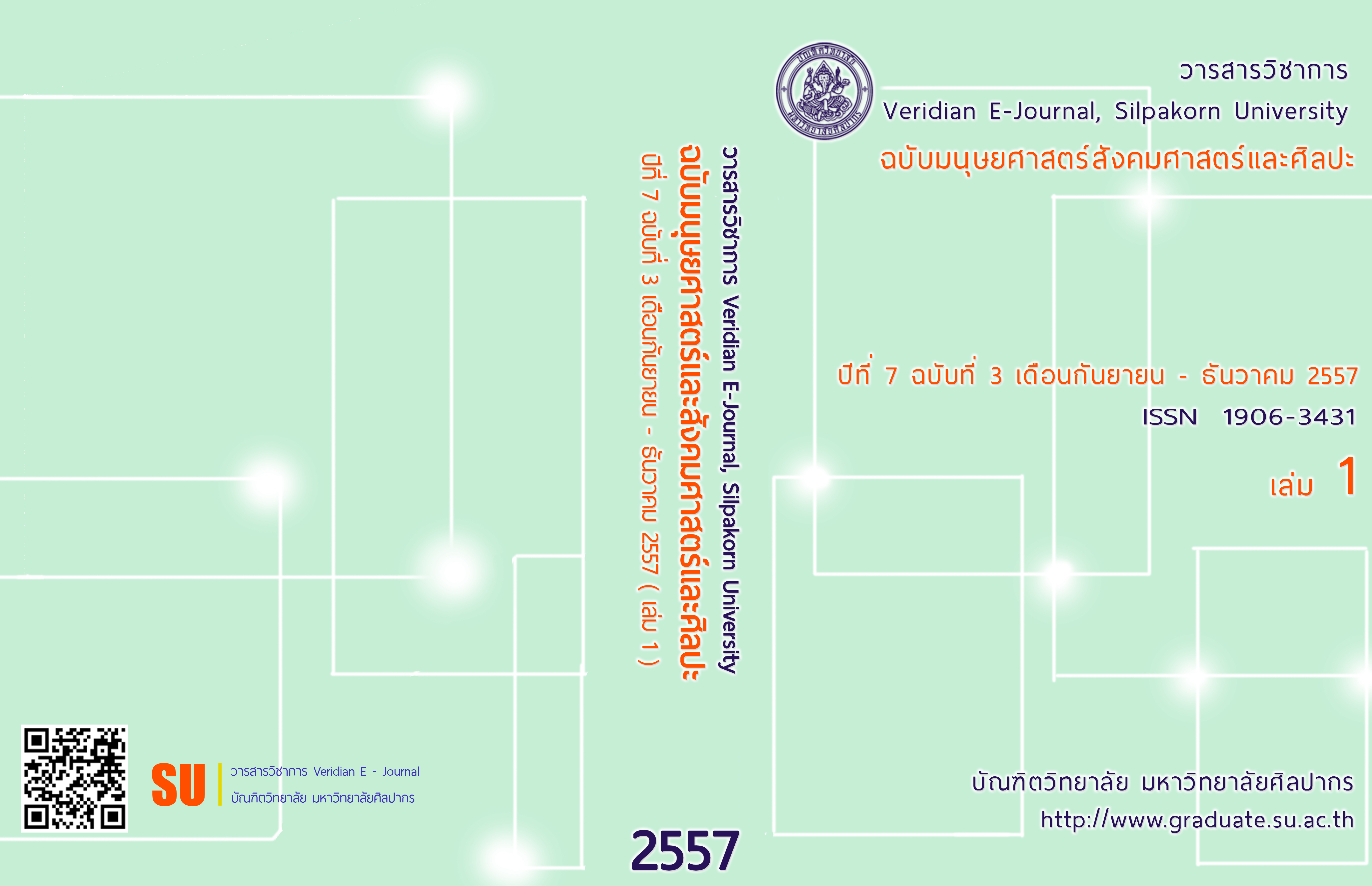การวิเคราะห์ลูกปัดแก้วจากเมืองโบราณสมัยทวารวดี ในภาคกลางของประเทศไทย
Main Article Content
บทคัดย่อ
บทคัดย่อ
ลูกปัดแก้วจากเมืองโบราณสมัยทวารวดีในภาคกลางของประเทศไทย เป็นหลักฐานทางโบราณคดีประเภทหนึ่งที่สามารถนำมาศึกษาความสัมพันธ์กับเมืองโบราณ หรือแหล่งโบราณคดี ที่มีอายุในช่วงระยะเวลาเดียวกันได้ ซึ่งเป็นการศึกษาทั้งทางกายภาพและศึกษาธาตุประกอบทางเคมี จากผลการศึกษาทางกายภาพ ได้แก่ การวัดขนาด ชั่งน้ำหนัก และจำแนกสี สรุปได้ว่า มีความนิยมลูกปัดแก้วทั้งหมด 12 รูปทรง ได้แก่ ทรงหลอด ทรงกระบอก ทรงกลม ทรงกลมรี ทรงถังเบียร์ ทรงวงแหวน ทรงแผ่นแบน ทรงกระบอกสี่เหลี่ยม ทรงทุ่น ทรงเม็ดมะยม ทรงหกเหลี่ยม และ ทรงมีร่องยาว สีที่นิยมมีทั้งหมด 10 สี ได้แก่ เขียว ฟ้า น้ำเงิน แดง ส้ม เหลือง ดำ ม่วง น้ำตาล และเส้นสี สำหรับผลการศึกษาธาตุประกอบทางเคมีของลูกปัดแก้ว ด้วยเครื่อง Electron Probe Micro-Analyzer (EPMA) สามารถจัดกลุ่มได้ทั้งหมด 7 กลุ่ม ได้แก่ faience K m-Na-Al m-Na-Ca Pb v-Na-Al และ v-Na-Ca จากผลการศึกษาทั้งหมด สามารถสรุปได้ว่ารูปทรง ที่มีความนิยมมากที่สุดคือ ทรงแผ่นแบน และสีที่นิยมมากที่สุดคือ สีแดง โดยพบในทุกแหล่งโบราณคดีที่นำมาทำการศึกษา และลูกปัดในกลุ่ม m-Na-Al เป็นกลุ่มที่พบเป็นจำนวนมากที่สุด โดยเป็นกลุ่มที่สัมพันธ์กับลูกปัดแก้วที่เรียกกันว่า ลูกปัดแบบอินโด-แปซิฟิก (Indo-Pacific beads) ซึ่งเป็นลูกปัดกลุ่มที่พบมากในแถบเอเชียตะวันออกเฉียงใต้ในช่วงระยะเวลาเดียวกัน อย่างไรก็ตาม แก้วกลุ่มอื่นๆ ที่ได้จากการจัดกลุ่มโดยใช้ธาตุประกอบทางเคมี สามารถอธิบายความสัมพันธ์ด้านการติดต่อค้าขายระหว่างเมืองทวารวดีกับภูมิภาคอื่นๆ ได้ เช่น แก้วกลุ่ม Faience และ m-Na-Ca เป็นกลุ่มแก้วที่มีต้นกำเนิดในแถบอาณาจักรอียิปต์และโรมัน แก้วกลุ่ม K เป็นแก้วกลุ่มที่มีต้นกำเนิดในอินเดีย และเอเชียตะวันออกเฉียงใต้ แก้วกลุ่ม Pb เป็นแก้วกลุ่มที่มีต้นกำเนิดในจีน แก้วกลุ่ม v-Na-AI เป็นแก้วกลุ่มที่มีต้นกำเนิดในหมู่เกาะสุมาตราเหนือ และแก้วกลุ่ม v-Na-Ca เป็นแก้วกลุ่มที่มีต้นกำเนิดในแถบตะวันออกกลาง
คำสำคัญ: ลูกปัดแก้ว สมัยทวารวดี ลูกปัดแบบอินโด-แปซิฟิก EPMA
Abstract
Glass Bead is the one of archaeological artifact that can study the relationship between Dvaravati ancient cities located in the Central Region of Thailand and other Dvaravati sites by using the data from physical and chemical analysis. The results of physical analysis by measuring weighing and colour classification showed that there were 12 forms of glass beads that were largely found in the Dvaravati ancient cities in the Central Region of Thailand. They were the tube shape, the cylinder shape, the spherical shape, the oblate shape, the barrel shape, the annular shape, the cylinder disk shape, the square cylinder shape, the collar shape, the melon shape, the faceted hexagonal sphere shape and the flute shape. They were categorised in 10 groups of colours, which were green, blue, dark blue, red, orange, yellow, black, purple, brown and striped bead. The result of chemical analysis by EPMA showed that the glass beads were categorised in 7 groups based on their chemical elements, which were faience, K, m-Na-Al, m-Na-Ca, Pb, v-Na-Al, and v-Na-Ca. Regarding the results of physical and chemical analysis, the cylinder disk bead was the most popular style and red colour was the most popular colour among the selected sites. Most of the beads found were m-Na-Al which was related with the Indo-Pacific beads that was also largely found in the same period in Southeast Asia. In addition, the other glass beads could lead to the assumption of bead trading between Southeast Asia and other regions, such as faience and m-Na-Ca beads from the Roman Empire, K beads from India and Southeast Asia, Pb from China, v-Na-AI from the North Sumatra Island and v-Na-Ca from the Middle East.
Abstract: Glass Bead, Dvaravati, Indo-Pacific glass bead, EPMA

